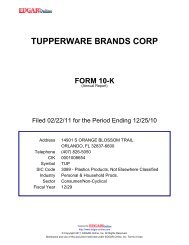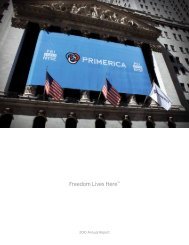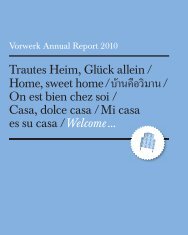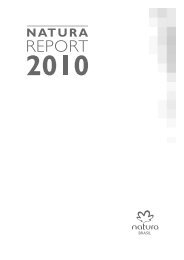Nu Skin 2010 Annual Report - Direct Selling News
Nu Skin 2010 Annual Report - Direct Selling News
Nu Skin 2010 Annual Report - Direct Selling News
Create successful ePaper yourself
Turn your PDF publications into a flip-book with our unique Google optimized e-Paper software.
closures related to vendor’s multiple-deliverable revenue arrangements.<br />
These amendments will be effective for our fiscal 2011 year end. We<br />
are currently evaluating the impact these amendments will have on<br />
our consolidated financial statements and disclosures.<br />
In June 2009, the FASB amended the consolidation accounting<br />
guidance. Effective January 1, <strong>2010</strong>, we are required to qualitatively<br />
assess the determination of our being the primary beneficiary (“consolidator”)<br />
of a variable interest entity (“VIE”) on whether we (1) have<br />
the power to direct matters that most significantly impact the activities<br />
of the VIE, and (2) have the obligation to absorb losses or the right to<br />
receive benefits of the VIE that could potentially be significant to the<br />
VIE. It also requires an ongoing reconsideration of the primary beneficiary<br />
and amends events that trigger a reassessment of whether an<br />
entity is a VIE. The new model is applicable to all new and existing<br />
VIEs. The adoption of this new guidance on January 1, <strong>2010</strong>, had no<br />
impact on our consolidated financial position or results of operation.<br />
In June 2009, the FASB amended the accounting guidance for<br />
determining whether a transfer of a financial asset qualifies for sale<br />
accounting. The amended guidance also provided four broad disclosure<br />
objectives designed to provide users of the financial statements<br />
with an understanding of.<br />
• the transferor’s continuing involvement with the transferred<br />
assets;<br />
• the nature of any restrictions on the transferor’s assets that relate<br />
to a transferred financial asset, including the carrying amount<br />
of those assets;<br />
• how servicing assets and servicing liabilities are reported by the<br />
transferor; and<br />
• how a transfer of financial assets affects the company’s balance<br />
sheet, earnings and cash flows.<br />
The prospective adoption of this guidance to new transfers of<br />
financial assets beginning January 1, <strong>2010</strong>, had no impact on our consolidated<br />
financial position or results of operation.<br />
CURRENCY RISK AND EXCHANGE RATE INFORMATION<br />
A majority of our revenue and many of our expenses are recognized<br />
outside of the United States, except for inventory purchases, which are<br />
primarily transacted in U.S. dollars from vendors in the United States.<br />
The local currency of each of our Subsidiaries’ primary markets is considered<br />
the functional currency. All revenue and expenses are translated<br />
at weighted-average exchange rates for the periods reported.<br />
Therefore, our reported revenue and earnings will be positively impacted<br />
by a weakening of the U.S. dollar and will be negatively impacted<br />
by a strengthening of the U.S. dollar. Given the large portion<br />
of our business derived from Japan, any weakening of the yen negatively<br />
impacts reported revenue and profits, whereas a strengthening<br />
of the yen positively impacts our reported revenue and profits. Given<br />
the uncertainty of exchange rate fluctuations, it is difficult to predict the<br />
effect of these fluctuations on our future business, product pricing and<br />
results of operation or financial condition. However, based on current<br />
exchange rate levels, we currently anticipate that foreign currency fluctuations<br />
will have a positive impact on reported revenue in 2011.<br />
We may seek to reduce our exposure to fluctuations in foreign<br />
currency exchange rates through the use of foreign currency exchange<br />
contracts, through intercompany loans of foreign currency and through<br />
our Japanese yen-denominated debt. We do not use derivative financial<br />
instruments for trading or speculative purposes. We regularly<br />
monitor our foreign currency risks and periodically take measures to<br />
reduce the impact of foreign exchange fluctuations on our operating<br />
results. At December 31, <strong>2010</strong>, we held forward contracts designated<br />
as foreign currency cash flow hedges with notional amounts totaling<br />
approximately $22.2 million to cash flow hedges for forecasted foreigncurrency-denominated<br />
intercompany transactions. At December 31,<br />
2009, we held forward contracts designated as foreign currency cash<br />
flow hedges with notional amounts totaling approximately $3.0 million<br />
to hedge forecasted foreign-currency-denominated intercompany<br />
transactions. Because of our foreign exchange contracts at December<br />
31, <strong>2010</strong>, the impact of a 10% appreciation or 10% depreciation of the<br />
U.S. dollar against the Japanese yen would not represent a material<br />
potential loss in fair value, earnings or cash flows against these contracts.<br />
This potential loss does not consider the underlying foreign currency<br />
transaction or translation exposures to which we are subject.<br />
49









